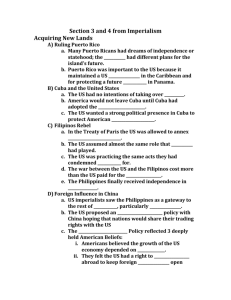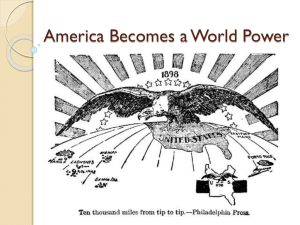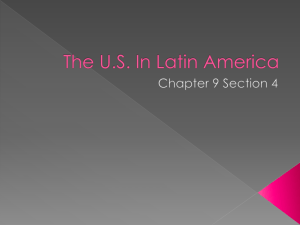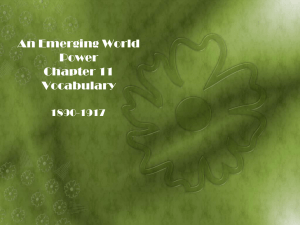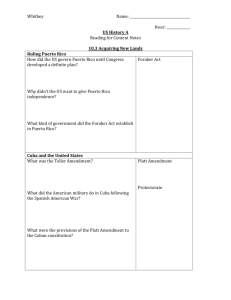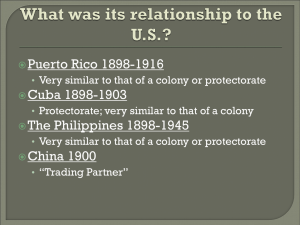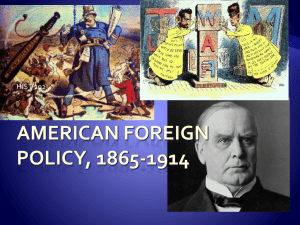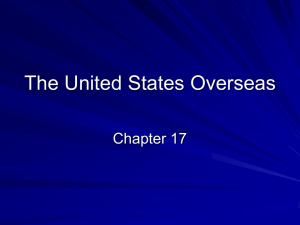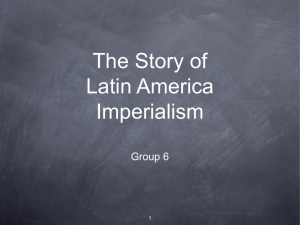Chapter 12—Becoming a World Power (1872-1912)
advertisement
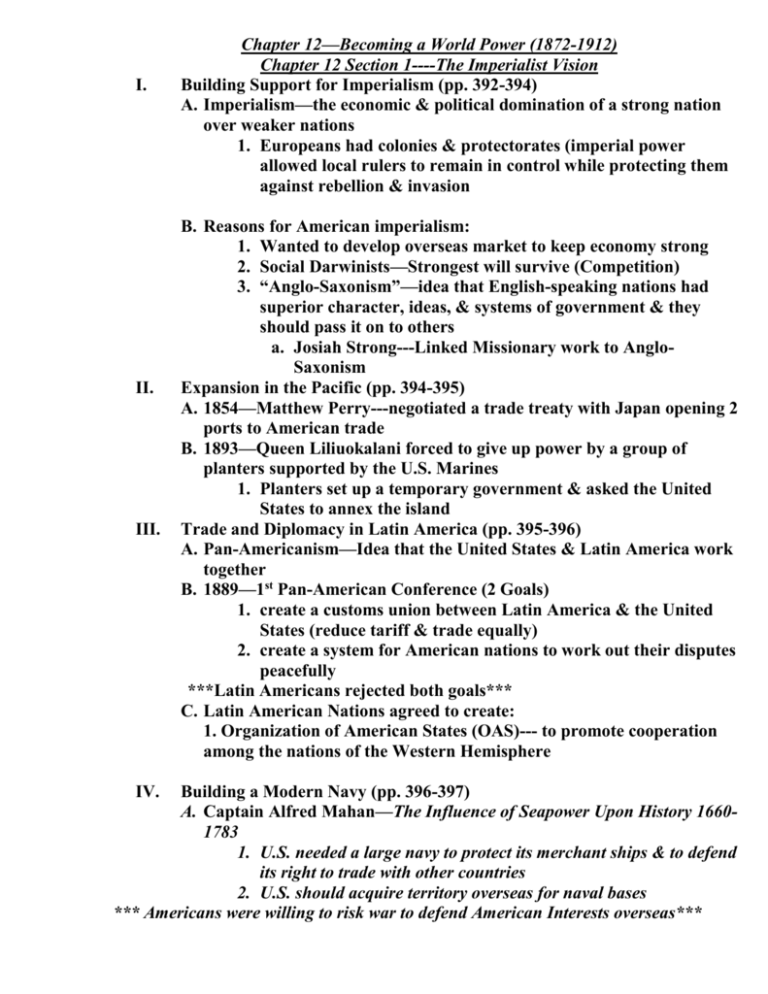
I. II. III. IV. Chapter 12—Becoming a World Power (1872-1912) Chapter 12 Section 1----The Imperialist Vision Building Support for Imperialism (pp. 392-394) A. Imperialism—the economic & political domination of a strong nation over weaker nations 1. Europeans had colonies & protectorates (imperial power allowed local rulers to remain in control while protecting them against rebellion & invasion B. Reasons for American imperialism: 1. Wanted to develop overseas market to keep economy strong 2. Social Darwinists—Strongest will survive (Competition) 3. “Anglo-Saxonism”—idea that English-speaking nations had superior character, ideas, & systems of government & they should pass it on to others a. Josiah Strong---Linked Missionary work to AngloSaxonism Expansion in the Pacific (pp. 394-395) A. 1854—Matthew Perry---negotiated a trade treaty with Japan opening 2 ports to American trade B. 1893—Queen Liliuokalani forced to give up power by a group of planters supported by the U.S. Marines 1. Planters set up a temporary government & asked the United States to annex the island Trade and Diplomacy in Latin America (pp. 395-396) A. Pan-Americanism—Idea that the United States & Latin America work together B. 1889—1st Pan-American Conference (2 Goals) 1. create a customs union between Latin America & the United States (reduce tariff & trade equally) 2. create a system for American nations to work out their disputes peacefully ***Latin Americans rejected both goals*** C. Latin American Nations agreed to create: 1. Organization of American States (OAS)--- to promote cooperation among the nations of the Western Hemisphere Building a Modern Navy (pp. 396-397) A. Captain Alfred Mahan—The Influence of Seapower Upon History 16601783 1. U.S. needed a large navy to protect its merchant ships & to defend its right to trade with other countries 2. U.S. should acquire territory overseas for naval bases *** Americans were willing to risk war to defend American Interests overseas*** I. II. III. Chapter 12 Section 2----The Spanish-American War The Coming of War (pp. 399-401) A. Events Leading Up to the Spanish-American War: 1. 1895—Jose Marti ---led a Cuban revolution against the Spanish 2. Yellow Journalism---exaggerated stories of Spanish attacks on Cubans a. William Randolph Hearst—New York Journal b. Joseph Pulitzer—New York World 3. Sp. General Weyler caused the deaths of thousands of Cubans by putting them in reconcentration camps (starvation & disease) 4. de Lome’s letter insulting President McKinley as being weak 5. Feb. 1898---Sinking of the U.S.S. Maine killing 266 Americans a. Spanish blamed for it even though no one knows why the ship exploded b. April 1898—U.S. declared war against Spain A War on Two Fronts (pp.401-403) A. Philippines 1. Commodore George Dewey destroyed Spanish warships in Manila Bay & also seized Guam a. Emilio Aguinaldo—Led Philippine rebellion against the U.S. (1899-1902) B. Cuba 1. U.S. Navy blockaded Cuba 2. June 1898 American troops advanced toward Santiago Harbor a.“Rough Riders” (Flamboyant mix of cowboys, miners, & law officers)---Led by Leonard Wood & Theodore Roosevelt 3. August 12, 1898—Spain & U.S. agreed to a cease fire An American Empire is Born (pp. 403-405) A. Treaty of Paris (1898) 1. Cuba gains its independence 2. U.S. acquired Puerto Rico & Guam 3. U.S. paid Spain $20 million for the Philippines *** Controlling its New Empire was not easy for the U.S.*** B. Philippines 1. Emilio Aguinaldo led revolution against U.S. soldiers 2. U.S. set up reconcentration camps to separate guerillas from civilians, but many died of starvation & disease 3. William Howard Taft—1st U.S. Governor of the Philippines a. introduced reforms in education, transportation & health care b. impact: hostility towards the U.S. lessened 4. 1946—Philippines granted their independence C. Puerto Rico 1. Foraker Act(1900)—made Puerto Rico an unincorporated territory a. Puerto Ricans not U.S. citizens & had no constitutional rights b. Congress could pass whatever laws they wanted on the island 2. 1917—Puerto Ricans made U.S. citizens 3. 1947—Puerto Ricans allowed to elect their own governor 4. Today---Debate to grant Puerto Rico statehood or to continue as a Commonwealth of the United States D. Cuba 1. Platt Amendment—U.S. established a military government a. Cuba could not make a treaty with another nation that would weaken its power or allow another foreign power to gain territory b. Cuba had to allow the United States to buy or lease naval stations in Cuba c. Cuba’s debts had to be kept low to prevent foreign countries from landing troops to enforce payments d. The United States would have the right to intervene to protect Cuban independence and keep order ***Platt Amendment repealed in 1934*** I. II. Chapter 12 Section 3—New American Diplomacy Theodore Roosevelt’s Rise to Power (pp. 408-409) A. Sept. 6, 1901—Leon Czolgost(an anarchist) assassinated President McKinley B. Theodore Roosevelt –42 years old—youngest U.S. President 1. believed the U.S. had a duty to shape the “less civilized” parts of the world 2. Wanted the U.S. to become a world power American Diplomacy in Asia (pp. 409-411) A. Sphere of Influence---an area where a foreign nation controlled economic development 1. China divided up into spheres of Influence by Germany, France, Russia, Great Britain B. Open Door Policy (1899)—Sec. Of State John Hay 1. believed that all countries should be allowed to trade with China C. Boxer Rebellion (1900)—Chinese trying to get rid of foreign control 1. An international force stopped the rebellion & the Open Door Policy continued D. Russo-Japanese War (1905) 1. President Roosevelt won the Nobel Peace Prize for negotiating a agreement 2. U.S.-Japan’s relationship worsened because each nation wanted greater influence in Asia 3. 1907—Great White Fleet (16 battleships)—sent around the world to show the U.S. had great military strength a. relations with Japan continued to be strained III. A Growing Presence in the Caribbean (pp. 412-413) A. Hay-Pauncefote Treaty(1901)—Gave the U.S. exclusive rights to build & control any proposed canal through Central America B. Colombia rejected an offer from the United States C. Panamanians rebelled against Colombia for their independence 1. U.S. supported the rebellion by sending ships to Panama to prevent Colombia from interfering 2. Rebellion led by Bunau-Varilla D. Panama Canal—(1904-1914) 1. short cut between the Atlantic & Pacific oceans 2. Disease, Mosquitoes, etc were big obstacles E. Roosevelt Corollary to the Monroe Doctrine (1904) 1. U.S. would intervene in Latin American affairs when necessary to maintain economic & political stability in the Western Hemisphere 2. Dominican Republic—1st applied in because they fell behind in their debt payments to European countries 3. Latin American nations resented the growing American influence F. Taft’s Dollar Diplomacy---believed that if American business leaders supported Latin America & Asian development, everyone would benefit 1. “substituting “dollars for bullets”
